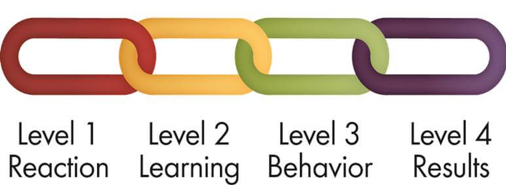The Kirkpatrick model[1]was developed in the 1950s by Donald Kirkpatrick as a way to evaluate the effectiveness of the training of supervisors and has undergone multiple iterations since its inception. It is one of the most widely used methods for evaluating the effectiveness of training programs, and has a review-oriented approach to evaluating what occurred and what the end results of training were. Designed with four levels of evaluation, the model gains in complexity across the levels.

The most recent iteration of the model was presented in 2010 as the New World Kirkpatrick Model. Users of the model can either choose to start at level 1 and work up the model in its complexity, or can choose to begin at level 4 and work backwards as a program is designed.
Process for Kirkpatrick
This Level 1 examines the degree to which participants enjoyed and were engaged by the material in the training. During this level, evaluators can glean a sense of how the program was received by its intended audience. Assessing this level of the model can provide insight into whether delivery or content should be improved or adjusted in some way.
The next level (2) builds off of the satisfaction scores to explore whether participants acquired the knowledge, skills, attitudes, confidence and commitment to the content of the training[2]. Often participants are queried on these areas using a survey tool. This level increases in its complexity of an evaluation to compare what the intended content of the training was with what the participants actually learned from it.
Level 3 evaluates whether participants plan to change their behaviors based on the training itself. Especially planning for how transferable the training is when the participants return to their jobs, the focus is on actionable change.
Finally, in Level 4 evaluators appraise the targeted outcomes as a result of the training. This level looks holistically at whether the intended goals of the program were achieved during training.
[1]https://www.kirkpatrickpartners.com/Our-Philosophy
[2]https://educationaltechnology.net/kirkpatrick-model-four-levels-learning…
